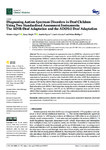Diagnosing Autism Spectrum Disorders in Deaf Children Using Two Standardised Assessment Instruments: The ADIR-Deaf Adaptation and the ADOS-2 Deaf Adaptation
| dc.contributor.author | Allgar, Victoria | |
| dc.contributor.author | Wright, B | |
| dc.contributor.author | Taylor, A | |
| dc.contributor.author | Couter, AL | |
| dc.contributor.author | Phillips, H | |
| dc.date.accessioned | 2021-10-25T11:16:16Z | |
| dc.date.issued | 2021-09-24 | |
| dc.identifier.issn | 2077-0383 | |
| dc.identifier.issn | 2077-0383 | |
| dc.identifier.other | ARTN 4374 | |
| dc.identifier.uri | http://hdl.handle.net/10026.1/18169 | |
| dc.description.abstract |
<jats:p>The aim was to investigate the agreement between the ADI-R Deaf adaptation and ADOS-2 Deaf adaptation overall diagnostic categorisation for autism (AUT) and a wider threshold to include autism spectrum (ASD) in a cohort of deaf children with and without ASD. We compared results of the instruments used on their own and when combined and propose standard criteria for the combined use of the ADI-R Deaf adaptation and ADOS-2 Deaf adaptation for use with deaf children. In total, 116 deaf children had a Gold standard NICE guideline assessment; 58 diagnosed with ASD and 58 without ASD, and for both groups a blinded informant based ADI-R Deaf adaptation and direct assessment using the ADOS-2 Deaf adaptation were separately completed. There was moderate agreement between the ADI-R Deaf adaptation and ADOS-2 Deaf adaptation for the wider threshold of ASD (Kappa, 0.433). To achieve the lowest number of false negatives, the most successful assessment tool approach is using the wider threshold of ASD with either ADI-R Deaf adaptation or ADOS-2-Deaf adaptation (95% sensitivity). This compares with 88% for the ADI-R Deaf adaptation alone and 74% for the ADOS-2-Deaf adaptation alone (wider threshold of ASD). To achieve a low number of false positives, the most successful assessment tool approach is a combination of ADI-R Deaf adaptation and ADOS-2- Deaf adaptation (using the narrow threshold of autism for both) (95% specificity). This compares with 83% for the ADI-R Deaf adaptation alone and 81% for the ADOS-2-Deaf adaptation (narrow threshold) alone. This combination is therefore recommended in specialist clinics for diagnostic assessment in deaf children.</jats:p> | |
| dc.format.extent | 4374-4374 | |
| dc.format.medium | Electronic | |
| dc.language | en | |
| dc.language.iso | en | |
| dc.publisher | MDPI | |
| dc.subject | autism spectrum disorder | |
| dc.subject | deaf | |
| dc.subject | child | |
| dc.subject | young person | |
| dc.subject | assessment | |
| dc.subject | diagnosis | |
| dc.subject | play based assessment | |
| dc.subject | semi-structured interview | |
| dc.title | Diagnosing Autism Spectrum Disorders in Deaf Children Using Two Standardised Assessment Instruments: The ADIR-Deaf Adaptation and the ADOS-2 Deaf Adaptation | |
| dc.type | journal-article | |
| dc.type | Journal Article | |
| plymouth.author-url | https://www.webofscience.com/api/gateway?GWVersion=2&SrcApp=PARTNER_APP&SrcAuth=LinksAMR&KeyUT=WOS:000707572200001&DestLinkType=FullRecord&DestApp=ALL_WOS&UsrCustomerID=11bb513d99f797142bcfeffcc58ea008 | |
| plymouth.issue | 19 | |
| plymouth.volume | 10 | |
| plymouth.publication-status | Published online | |
| plymouth.journal | Journal of Clinical Medicine | |
| dc.identifier.doi | 10.3390/jcm10194374 | |
| plymouth.organisational-group | /Plymouth | |
| plymouth.organisational-group | /Plymouth/Faculty of Health | |
| plymouth.organisational-group | /Plymouth/Faculty of Health/Peninsula Medical School | |
| plymouth.organisational-group | /Plymouth/REF 2021 Researchers by UoA | |
| plymouth.organisational-group | /Plymouth/REF 2021 Researchers by UoA/UoA01 Clinical Medicine | |
| plymouth.organisational-group | /Plymouth/Research Groups | |
| plymouth.organisational-group | /Plymouth/Research Groups/Plymouth Institute of Health and Care Research (PIHR) | |
| plymouth.organisational-group | /Plymouth/Users by role | |
| plymouth.organisational-group | /Plymouth/Users by role/Academics | |
| dc.publisher.place | Switzerland | |
| dcterms.dateAccepted | 2021-09-20 | |
| dc.rights.embargodate | 2021-10-26 | |
| dc.identifier.eissn | 2077-0383 | |
| dc.rights.embargoperiod | Not known | |
| rioxxterms.versionofrecord | 10.3390/jcm10194374 | |
| rioxxterms.licenseref.uri | http://www.rioxx.net/licenses/all-rights-reserved | |
| rioxxterms.licenseref.startdate | 2021-09-24 | |
| rioxxterms.type | Journal Article/Review |


